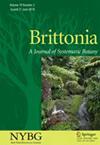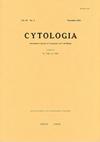Quantitative Biology
期刊缩写:
Quant Biol
 复制
复制
 反馈
反馈
影响因子:
期刊影响因子(Impact factor,IF) 即某刊平均每篇论文的被引用数,是表征期刊影响大小的一项定量指标,它实际上是某刊在某年被全部源刊物引证该刊前两年发表论文的次数,与该刊前两年所发表的全部源论文数之比。
0.6
 反馈
反馈
ISSN:
ISSN是由8个数字组成的编码,旨在识别各种报纸、专业杂志、画报、期刊,无论其性质或载体版本(纸版及电子版)。
print: 2095-4689
on-line: 2095-4697
研究领域:
MATHEMATICAL & COMPUTATIONAL BIOLOGY
Gold OA文章占比:
Gold OA文章占比是指一个总体中金色OA文章数量占总体文章数量的比重。OA期刊的文章主要通过金色通道(Gold road,也称为Gold OA,即期刊官网)和绿色通道(Green road,或Green OA)实现开放获取。金色通道是开放获取期刊通过自己的官网来实现的,而绿色通道是通过把文章自存档于机构知识库(Institutional Repositories,比如哈佛大学学术库DASH)或学科知识库中来实现。
96.59%
SCI收录类型:
Emerging Sources Citation Index (ESCI) || Scopus (CiteScore)
主办单位:
Higher Education Press,China;Tsinghua University,China
期刊介绍英文:
Quantitative Biology is an interdisciplinary journal that focuses on original research that uses quantitative approaches and technologies to analyze and integrate biological systems, construct and model engineered life systems, and gain a deeper understanding of the life sciences. It aims to provide a platform for not only the analysis but also the integration and construction of biological systems. It is a quarterly journal seeking to provide an inter- and multi-disciplinary forum for a broad blend of peer-reviewed academic papers in order to promote rapid communication and exchange between scientists in the East and the West. The content of Quantitative Biology will mainly focus on the two broad and related areas: ·bioinformatics and computational biology, which focuses on dealing with information technologies and computational methodologies that can efficiently and accurately manipulate –omics data and transform molecular information into biological knowledge. ·systems and synthetic biology, which focuses on complex interactions in biological systems and the emergent functional properties, and on the design and construction of new biological functions and systems. Its goal is to reflect the significant advances made in quantitatively investigating and modeling both natural and engineered life systems at the molecular and higher levels. The journal particularly encourages original papers that link novel theory with cutting-edge experiments, especially in the newly emerging and multi-disciplinary areas of research. The journal also welcomes high-quality reviews and perspective articles.
CiteScore:
引用分数(英语:CiteScore,CS)是一种用来反映学术期刊最近发表文章“年平均被引用次数”的衡量指标。该指标由Elsevier于 2016 年 12 月推出,以替代常用的JCR影响因子(由Clarivate计算)。 CiteScore是Scopus中系列期刊指标的一部分,包括 SNIP(源文档标准化影响),SJR (SClmago杂志排名),引用文档计数以及引用百分比。
| CiteScore | SJR | SNIP | CiteScore排名 |
|---|
| 5.0 | 0.631 | 0.418 | 大类:Mathematics
小类:Applied Mathematics 99 / 635 84% 大类:Mathematics
小类:Modeling and Simulation 75 / 324 77% 大类:Biochemistry, Genetics and Molecular Biology
小类:Biochemistry, Genetics and Molecular Biology (miscellaneous) 25 / 103 76% 大类:Computer Science
小类:Computer Science Applications 318 / 817 61% |
发文信息
中科院SCI期刊分区
中科院分区升级版是在基础版的基础上,消除了对预置学科体系的依赖,例如期刊-学科隶属关系。基于概率统计原理的期刊超越指数,使分区结果更加鲁棒,不易操纵,揭示出更多优秀的基础研究期刊。
2019-2021年,3年过渡期,会同时发布基础版和升级版,便于用户单位过渡、调整。2022年开始,将只发布升级版。
|
大类
|
小类
|
TOP期刊
|
综述期刊
|
|
4区
生物学
|
4区
数学与计算生物学
MATHEMATICAL & COMPUTATIONAL BIOLOGY
|
否
|
否
|
WOS期刊分区
WoS-JCR分区:SCIE、SSCI收录期刊主要按影响因子高低被分为四个区(Quartile),分别是Q1区,Q2区,Q3区,Q4区,各占25%。Q1区是影响因子最靠前25%的期刊,Q4区是靠后的25%的期刊。
| 学科分类 |
|---|
Q4MATHEMATICAL & COMPUTATIONAL BIOLOGY |
历年影响因子
历年发表
年文章数是指每年6月SCI发布的IF数据中所提供的上一年全年发文数量。如2018年7月-2019年6月,显示的是2017年的发文数.对极少数热门期刊,我们会在1月份更新为最新一年的发文数。
| 2013年 | 2014年 | 2015年 | 2016年 | 2017年 | 2018年 | 2019年 | 2020年 | 2021年 | 2022年 |
| 25 | 13 | 20 | 33 | 37 | 30 | 29 | 41 | 47 | 10 |
投稿信息
出版商:
Higher Education Press
同类期刊
Quantitative Biology - 最新文献
查看全部
Pub Date : 2024-12-01
DOI: 10.1002/qub2.67
Jinge Wang, Zien Cheng, Qiuming Yao, Li Liu, Dong Xu, Gangqing Hu
Pub Date : 2024-12-01
DOI: 10.1002/qub2.57
Muhammad Azam, Yibo Chen, Micheal Olaolu Arowolo, Haowang Liu, Mihail Popescu, Dong Xu
Pub Date : 2023-12-01
DOI: 10.1002/qub2.26
Ke Feng, Hongyang Jiang, Chaoyi Yin, Huiyan Sun
免责声明:
本页显示期刊或杂志信息,仅供参考学习,不是任何期刊杂志官网,不涉及出版事务,特此申明。如需出版一切事务需要用户自己向出版商联系核实。若本页展示内容有任何问题,请联系我们,邮箱:info@booksci.cn,我们会认真核实处理。







 扫码关注我们
扫码关注我们

